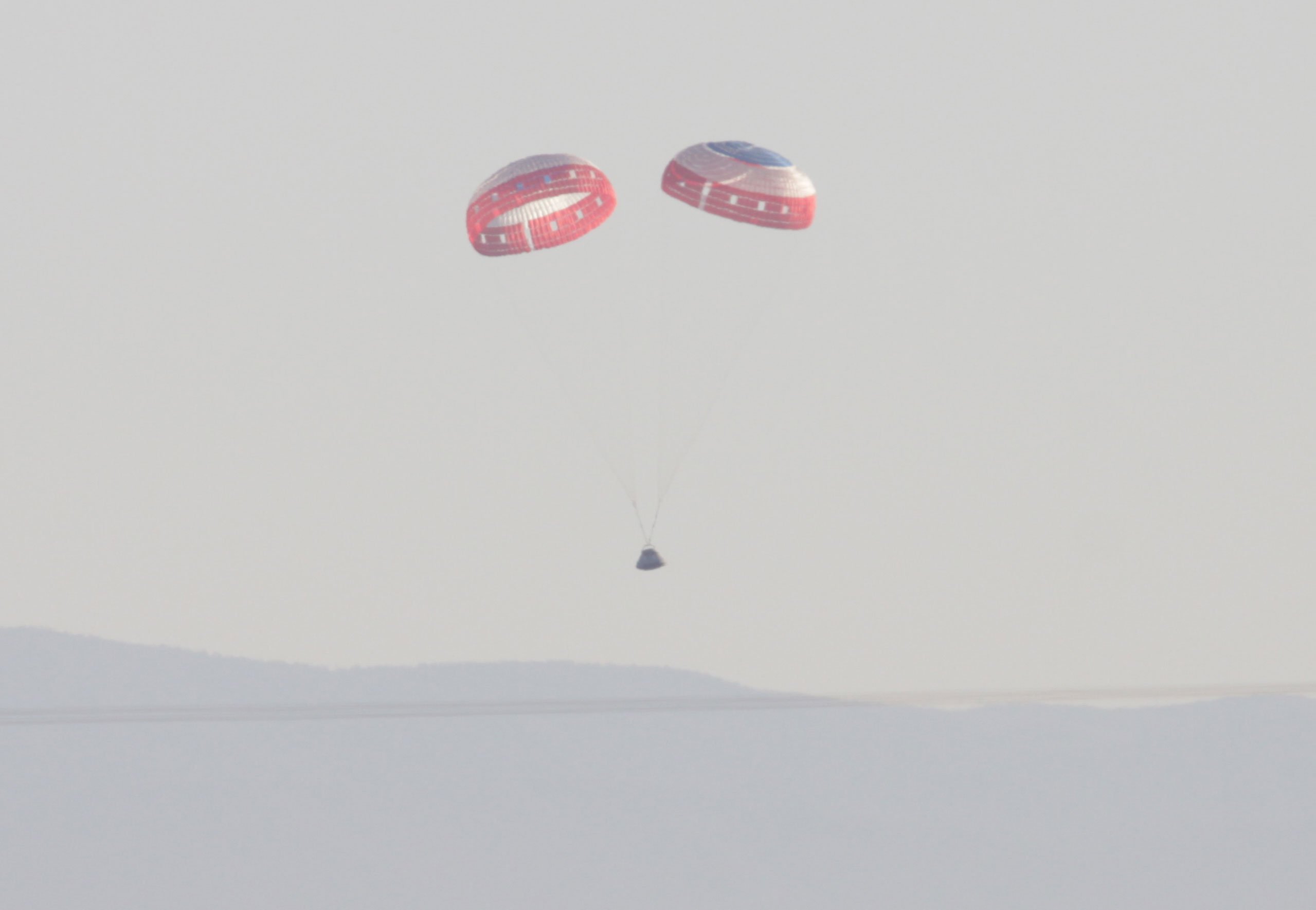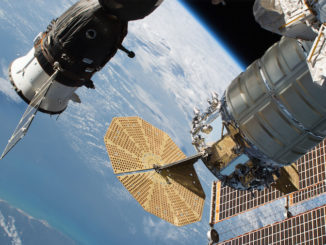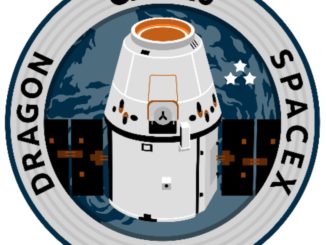
Boeing specialists working inside a former space shuttle hangar in Florida started fueling the company’s first spaceflight-ready Starliner capsule this week ahead of the ship’s rollout to its launch pad later this month.
The fueling milestone is a major step in the Starliner launch campaign. Boeing is targeting liftoff from Cape Canaveral on Dec. 17 on a week-long demonstration mission to the International Space Station.
The start of fueling of the first Starliner spacecraft bound for the space station comes after engineers concluded that human error led to a parachute deployment malfunction during a crew capsule abort test Monday.
Boeing and NASA officials briefed reporters Thursday on the initial results from the Starliner pad abort test, in which high-power escape engines pushed the spacecraft off its test stand at White Sands Missile Range in New Mexico with some 180,000 pounds of thrust.
The capsule used thrusters to flip around and point its base heat shield toward the ground after the five-second firing of the ship’s abort engines. Only two of the three main parachutes deployed, an issue Boeing has attributed to the lack of a secure connection between the pilot chute and one of the main chutes.
The capsule’s service module then jettisoned to fall to the ground, and the Starliner released its base heat shield and inflated airbags to cushion the craft’s landing around a mile downrange from the launch site.
Data analyzed so far from Monday’s pad abort test suggests the escape engines functioned properly, according to John Mulholland, Boeing’s commercial crew vice president and Starliner program manager.
“The spacecraft performance, the test team performance, was outstanding,” he said. “The vehicle trajectory that it flew was right on top of pre-test predictions. The abort engine burn was nominal, the startup was good, the shutdown was good.”
“The forward heat shield, the ascent cover, the service module, and the (base) heat shield and the airbag deployment and d0operation were all nominal,” Mulholland said. “So (an) outstanding success for the spacecraft and the test team.”
Boeing engineers have identified what caused one of the capsule’s three main parachutes to not deploy Monday.
“The root cause was a lack of secure connection between the pilot chute and the main chute lanyard,” Mulholland said. “By design, the pilot parachute fires out through a mortar, and once that pilot parachute inflates, it actually pulls the main parachute out. But that lack of adequate connection didn’t allow the pilot parachute to pull out the main parachute.”
Mulholland said engineers quickly identified the problem after reviewing close-out photos of the parachutes, and through inspections of hardware recovered after Monday’s pad abort test in New Mexico.
“The pilot chute has has a Kevlar riser with a loop at the end of it,” Mulholland said. “The linkage is a pin, so a pin would normally be inserted into that loop and secured. That linkage and the pilot parachute riser (are) enclosed in a sheath, a protective sheath that prevents abrasion. So it’s very difficult, when you’re connecting that, to verify visually that it’s secured properly.
“In this particular case, that pin wasn’t through the loop, but it wasn’t discovered in initial visual inspection because of that protective sheath,” Mulholland said. “It was subsequently … determined by both detailed close-out photos and then, obviously, when we recovered the hardware in the field, were able to conclusively tie those two pieces together.”
So far, Boeing has confirmed the linkages between the next spacecraft’s pilot and main parachutes were all connected correctly. Ground teams are now verifying all parachute connections are properly secured before its scheduled launch next month on an unpiloted test flight to the International Space Station, Mulholland said.
The parachutes are already packed for launch. If engineers find a problem in the parachute close-out photos, the Starliner’s launch date of Dec. 17 could be put in jeopardy.
Mulholland and Kathy Lueders, manager of NASA’s commercial crew program, said NASA performs process checks throughout assembly of Starliner spacecraft to address potential quality control concerns.
“These are areas that we actually do process checks on, and with this being a flight test, there wasn’t a process check here,” Lueders said. “But there’s process checks that we have on our flight vehicles going forward because we know that these linkages are very, very important for the chute to be working right … This is just another place where we’ll be working with Boeing going forward, and put together joint action plans for us to address any concerns on different areas that we have.”
According to Mulholland, the capsule’s safe landing under two parachutes Monday proved each chute can sustain more than the required loads.
“What we saw was not a parachute failure,” he said. “And, in fact, the operation of this test and the conclusion of this test under two chutes will provide us invaluable engineering data. It validates the performance of the chute significantly beyond any design requirement, and it further validates the robustness of our spacecraft and our design.”
NASA awarded Boeing a $4.2 billion contract in 2014 to develop and build Starliner crew capsules. The agency also awarded a $2.6 billion deal to SpaceX for the Crew Dragon spacecraft. Both vehicles are now in the final stages of development, with crewed missions scheduled to begin next year.

SpaceX has encountered parachute failures during drop tests. A series of tests of an upgraded parachute design is now underway to prove the chute’s readiness for Crew Dragon missions.
“Parachutes are really very complex,” Mulholland said. “They seem simple in their design, but the sequencing of the parachutes, their inflation, their ability to counteract the load from the spacecraft coming in from orbit, and the interaction with all of the aerodynamic conditions of the day gets to be very complex.
“It’s one of the areas that is really hard to model and have high confidence in the model, so confidence in parachute systems are largely generated by a number of tests in both nominal and off-nominal conditions.”
The unique sequence of Monday’s pad abort test proved that two of the Starliner’s main parachutes could slow the capsule’s descent for a safe landing.
What’s more, the parachutes unfurled with the Starliner’s service module still attached. During a return from space, the Starliner will jettison its propulsion module to burn up in the atmosphere, while the reusable crew module comes back to Earth with the astronauts.
The test Monday demonstrated “the ability of the two chutes to be able to handle approximately 30 percent higher loads, due to the service module being on there.”

Boeing officials said they do not expect any impact from the pad abort test’s parachute issue on the scheduled for the Starliner’s Orbital Flight Test, the capsule’s first unpiloted mission to space.
United Launch Alliance erected the first stage of the Starliner’s Atlas 5 rocket Monday. ULA installed the Atlas 5’s two strap-on solid rocket boosters Wednesday and Thursday. The Atlas 5’s Centaur upper stage will be hoisted atop the rocket to complete the initial build-up of the launcher inside the Vertical Integration Facility at Cape Canaveral’s Complex 41 launch pad.
Fueling of the Starliner with its mixture of hydrazine and nitrogen tetroxide maneuvering propellants should be completed Monday, a Boeing spokesperson said. The spacecraft will roll out of its manufacturing facility at the Kennedy Space Center in mid-November to head for the Atlas 5 launch pad, where cranes will lift it on top of the launch vehicle for final pre-flight checkouts.
Email the author.
Follow Stephen Clark on Twitter: @StephenClark1.



